|
Mark
Watson (Nashville, GA)
This page is a continuation of my
introduction because it explains in more detail my
nostalgic attachment to cane mills. It all started with my
maternal grandfather, Mark A. Watson, who was a syrup
maker. Grandpa was a lovely man, far kinder than his time
and circumstances would have suggested.
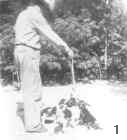 Although
exercising dominion over beasts was part and parcel of his
culture and livelihood, he had a special relationship with
and respect for animals as indicated by this photograph
from the 1930s (Slide
1). As an undisciplined youngster, I sought amusement
from animals, but Grandpa’s disapproval was enough to
cause me to stop dropping out of pecan trees onto the
backs of unsuspecting cows or using birds for target
practice. Although
exercising dominion over beasts was part and parcel of his
culture and livelihood, he had a special relationship with
and respect for animals as indicated by this photograph
from the 1930s (Slide
1). As an undisciplined youngster, I sought amusement
from animals, but Grandpa’s disapproval was enough to
cause me to stop dropping out of pecan trees onto the
backs of unsuspecting cows or using birds for target
practice.
Grandpa didn’t have much use
for bossing in either direction, which suited me fine and
provided me some relief from my grandmother, who was
opposite in every way. He said what was necessary, which
was usually not too much; in fact, it could be very little
indeed under circumstances that need not be described
here.
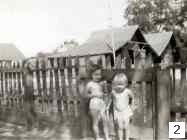 In
a way, I felt that my older sisters were luckier than I
was because they were born in Grandpa’s house, as was my
mother, and lived on the farm, which was less than
one-half mile from Grandpa’s. When this photograph (Slide
2) was made in 1942, they were the only grandchildren.
Della Faye (Slide 2) died suddenly (obituary , photograph) within the year,
leaving Carolyn as the only grandchild, except for an
infant cousin. The upper left in this photograph shows the
edge of the Sugar Mill Yard, about which more later. (The
buildings in the upper right were remodeled and combined
before the aerial view below was taken.) Note the
grass-free yard; any plant in the yard was a weed. The
stated reason was to keep snakes away, but this custom
must have deep cultural roots, like burning leaves in the
fall. Though not to the precision of a Japanese garden, it
was an almost weekly task to sweep the yard with a broom
made of gallberry, better loved by me because it is a
honey plant. One notes also the paling fence, which
surrounded country homes to keep domestic animals out. In
a way, I felt that my older sisters were luckier than I
was because they were born in Grandpa’s house, as was my
mother, and lived on the farm, which was less than
one-half mile from Grandpa’s. When this photograph (Slide
2) was made in 1942, they were the only grandchildren.
Della Faye (Slide 2) died suddenly (obituary , photograph) within the year,
leaving Carolyn as the only grandchild, except for an
infant cousin. The upper left in this photograph shows the
edge of the Sugar Mill Yard, about which more later. (The
buildings in the upper right were remodeled and combined
before the aerial view below was taken.) Note the
grass-free yard; any plant in the yard was a weed. The
stated reason was to keep snakes away, but this custom
must have deep cultural roots, like burning leaves in the
fall. Though not to the precision of a Japanese garden, it
was an almost weekly task to sweep the yard with a broom
made of gallberry, better loved by me because it is a
honey plant. One notes also the paling fence, which
surrounded country homes to keep domestic animals out.
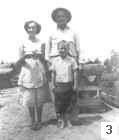 Some
years later, I was born and Grandpa’s house became my
secondary and sometime primary residence. One of my
favorite photographs (Slide
3) shows my sister, my grandfather and me when the
world was my playground. Because of his debilitating
arthritis, I was of use to Grandpa and he had time for me.
I don’t think he ever said an unkind word to me, which
is in marked contrast to the behavior of many adults then
toward children or anyone they deemed inferior for some
reason. I suffered my first setback at age 13 on October
2, 1959, when he died. I took to the woods, as he probably
would have done if the situation had been reversed. Some
years later, I was born and Grandpa’s house became my
secondary and sometime primary residence. One of my
favorite photographs (Slide
3) shows my sister, my grandfather and me when the
world was my playground. Because of his debilitating
arthritis, I was of use to Grandpa and he had time for me.
I don’t think he ever said an unkind word to me, which
is in marked contrast to the behavior of many adults then
toward children or anyone they deemed inferior for some
reason. I suffered my first setback at age 13 on October
2, 1959, when he died. I took to the woods, as he probably
would have done if the situation had been reversed.
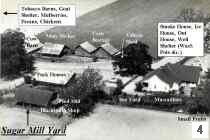 My
grandfather inherited two joining farms from his father,
Sam Watson. Grandpa Sam purchased the farms from Steve
Lewis in 1905 or 06. My father’s maternal grandfather
(which is as much to say, Jerry "Buck" Sutton)
had purchased the farm to the east from Mr. Lewis in 1878,
and Aunt
Lena inherited the farm to the south from Mr. Lewis,
her maternal grandfather. One farm (Slide
4) was “built up” and was the site of the home, a
smoke house, an ice house, a wash shelter (well, wash pots
for rendering fat, &c.), a large cow barn, a mule
barn, two corn houses, two pack houses (for tobacco then,
but for cotton earlier), a goat shelter, chicken houses,
and, of course, a sugar-mill yard. The sugar-mill yard was
covered with an open shelter, with the mill in the center
and the kettle and furnace on one side. A blacksmith shop
and a feed mill shared the shelter with the cane mill and
the kettle. In Grandpa's later years, the blacksmith shop
was barely used; it became a storage room for cans of
syrup. These syrup cans could be had for $3.75 per 50 from
Ward's in 1936, the last year my mother lived at home. The
syrup cans were recycled, of course, and found such uses
as being lunch pails for the school children at Deep Ditch
and as a container for miscellaneous items that were not
worth saving. During my childhood, the sugar-mill yard was
filled with family twice each year-for syrup making and
for hog killing (the syrup kettle doubled as a scalding
pot for hogs in preparation for removing the hair). My
grandfather inherited two joining farms from his father,
Sam Watson. Grandpa Sam purchased the farms from Steve
Lewis in 1905 or 06. My father’s maternal grandfather
(which is as much to say, Jerry "Buck" Sutton)
had purchased the farm to the east from Mr. Lewis in 1878,
and Aunt
Lena inherited the farm to the south from Mr. Lewis,
her maternal grandfather. One farm (Slide
4) was “built up” and was the site of the home, a
smoke house, an ice house, a wash shelter (well, wash pots
for rendering fat, &c.), a large cow barn, a mule
barn, two corn houses, two pack houses (for tobacco then,
but for cotton earlier), a goat shelter, chicken houses,
and, of course, a sugar-mill yard. The sugar-mill yard was
covered with an open shelter, with the mill in the center
and the kettle and furnace on one side. A blacksmith shop
and a feed mill shared the shelter with the cane mill and
the kettle. In Grandpa's later years, the blacksmith shop
was barely used; it became a storage room for cans of
syrup. These syrup cans could be had for $3.75 per 50 from
Ward's in 1936, the last year my mother lived at home. The
syrup cans were recycled, of course, and found such uses
as being lunch pails for the school children at Deep Ditch
and as a container for miscellaneous items that were not
worth saving. During my childhood, the sugar-mill yard was
filled with family twice each year-for syrup making and
for hog killing (the syrup kettle doubled as a scalding
pot for hogs in preparation for removing the hair).
I was born on a wave of change;
the Great Generation had just saved the world from
insatiable imperialism, unbridled racism, and nationalism
run amok. Ten years earlier in the rural South, mule
power, extended families, outhouses, and the lack of
electricity had been the norm during a depression that
worked with money-lenders to tear land from the yeomanry.
Ten years later, TVs, automobiles and tractors, were all
in the hands of prosperous land-owning farmers, although
the lower economic classes, the tenant farmers and, worse,
the day laborers did not share in the new-found wealth. .
. . and many younger people had quietly left the
countryside to find opportunities in distant cities.
Although this demographic shift occurred in most families,
including my father’s, all of my Grandfather Watson’s
family remained nearby except, of course, during the war.
Syrup making was not immune to
the change. In my childhood, it was a family tradition, as
described above, but earlier, syrup had been produced as a
source of income, and I beg leave to describe what I have
been told about my grandfather’s syrup operation in the
1930s. This was a time, generally, when small farmers were
lucky to hold onto their land, when children were excited
to receive a few pieces of fruit for Christmas, admission
to the local theatre could be paid in eggs, and when my
grandmother baked sweets for sale at the “curb market,”
just off the square in Nashville. Darkness was lifted from
the sugar-mill yard when a burly gentleman, Hamp Harrison
of Quitman, GA, installed a Delco plant about 1933. This
electrical plant consisted of 16 rectangular glass
batteries and a generator that was fed five gallons of
gasoline each Saturday morning. (The pole behind Carolyn
and Della Faye (Slide
2) distributed power to all the outbuildings.) With
protection by the shelter and illumination, syrup could be
made continuously over six long days each week. Therefore,
for a month each fall, the kettle boiled, making up to 5
kettles per day. This will seem like a lot to present-day
syrup makers who do not have a barrel of juice before
daybreak and who quit before 10 pm. It is true, however,
because both my uncles, Sam and Herbert, told me so and
neither would go to the trouble to lie. The syrup was made
for family use, to sell, and to trade to Levin’s
traveling grocery truck. But, the operation was more than
all that; it was a community affair. Mr. Ab May then lived
on the farm to the west (which belonged to my grandfather’s
sister, being inherited from Grandpa Sam). Mr. Jim
Warren lived on the next farm. Mr. May and Mr. Warren and
their families joined in, bringing their cane, so the mill
was a community center for a month and visitors from
nearby Nashville were regular. It is my understanding that
my grandfather enjoyed the camaraderie with them, but was
less encouraging to others who did not take care with the
equipment or hygiene. He knew how he wanted things taken
care of, and I understand that more than most will know. I
figure I take about as good care of his 1956 Ford 640 as
he did.
As a matter of information, at
about this same time, Earl Carter had a pretty good-sized
sugarcane syrup operation about 100 miles to the
northwest. For a view of a larger syrup-making operation
in those times, see the autobiography of his son (Carter J
(2001) An hour before Daylight. Simon & Schuster, New
York).
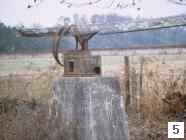
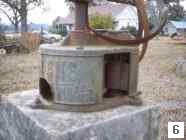
Pictures above (Slide
5 & Slide
6) are of the mill, a Golden New Model # 2. This mill
is one of the earliest New Models-it has a small plate
attached to the top plate indicating that the patent was
applied for. This would place its manufacture about
1904-1906 and most likely, the latter part of 1905.
(Thanks to Ken for the details of the patents covering
that mill.) No one remembers when the sugar-mill yard was
built. My late mother, who was born in 1918, said that the
mill had “always” been there. It seems likely that
Grandpa Sam built it right after he bought the place. It
would have taken a bit of capitol to buy the three farms
and especially to construct the buildings. Earlier, the
Watsons had owned land to the east and perhaps its sale
provided currency. In any case, the Watsons were pretty
well established in that part of the county, having
arrived about 1813.
The concrete support for the mill
was built about 1930, which my uncle Sam can barely
remember, but there is no information about the
predecessor structure. In general, however, cypress was
used for building posts. Also, note that the sweep was
mounted horizontally and adapted to an angled sweep lever
(which was the default supplied with this mill). The sweep
itself was made of an L-shaped cypress log. This
arrangement permitted one to work more easily around the
mill as Cora, the last mule, circled endlessly.
It is entirely possible that the
real reason to put these pages up is to remember Cora, old
Cora with her soulful eyes, calculated moves, and stoic
demeanor. According to my uncle Sam, Cora came to the farm
in either 1923 or 1924. Cora worked hard and trained
another mule to work by coupling to a double tree. In my
youth, John Deere had marginalized her. I do not remember
that she worked so much, but she still had to be fed and
watered. As a practical man who raised a family during the
depression, who had weathered the loss of a tobacco crop
(the only cash crop) due to a late freeze, who had seen
his hogs wasted by cholera, Grandpa sold Cora for glue in
about 1955, and meaning no disrespect, I am glad he was
never paid. Loving animals more than being practical, this
sale is still an issue with me. Cora's barn was jacked up
to accommodate one of the first, if not the first,
combination corn picker/shellers in the area. Then, the
barn fell. Now, there is no trace, except for Cora's well,
which being mine now is under no threat and stands as her
monument.
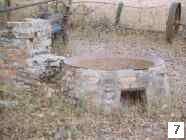 Slide
7 shows the kettle and what is left of the wood
furnace. Sadly, the memories are even more fragile than
the bricks. Slide
7 shows the kettle and what is left of the wood
furnace. Sadly, the memories are even more fragile than
the bricks.
After the cane, the syrup, and
the juice, the pomace (bagasse) still had to be dealt
with. (Pomace, incidentally, came into English in the
1700s from French (pomme = apple) and originally from
Latin. At first, it meant the apple residue after cider
had been pressed, but was soon adapted to mean many kinds
of pulp, even fish pulp. Many variant spelling are used (pommey,
pummy, pummyse, pommice, and probably several others that
the Oxford English Dictionary compilers don’t know
about.) In one or another place, pomace is used for
fodder, fuel and fiber. As did others, my Grandfather
placed it in the cow barn, where it provided bedding. Over
winter, it degraded. But, to give you a contrast with the
high-falutin etymology above, I will get down to the
nitty-gritty of pomace disposal. In short, it became a
personal affair, because whatever it degrades into was
mixed in with whatever cow manure degrades into, which in
sum is fertilizer and not to be wasted. During the winds
of March, the floor of the cow barn was cleaned out and
the fertilizer was put on a wagon and taken to the field,
which was all easy enough. Unfortunately, though, my
grandfather did not have a fertilizer distributor; he had
several, including me. We fashioned large aprons from
burlap with holes cut for our head and arms; the backs of
the apron were pinned with nails. With each of the front
corners pulled up by the respective hand, a nice large
fertilizer pouch was formed. With the pouch full, we
walked down the opened row sifting fertilizer into the
furrow. When the tug of the good old days seems more than
I can bear, I just imagine a day of distributing
fertilizer, dusty fertilizer in the wind, with all the
moist epithelial junctions caked and I pull back to the
twenty-first century with a smile.
|